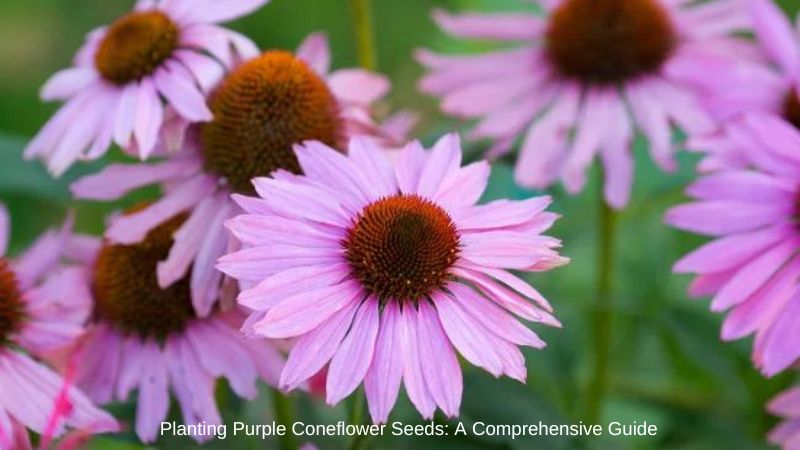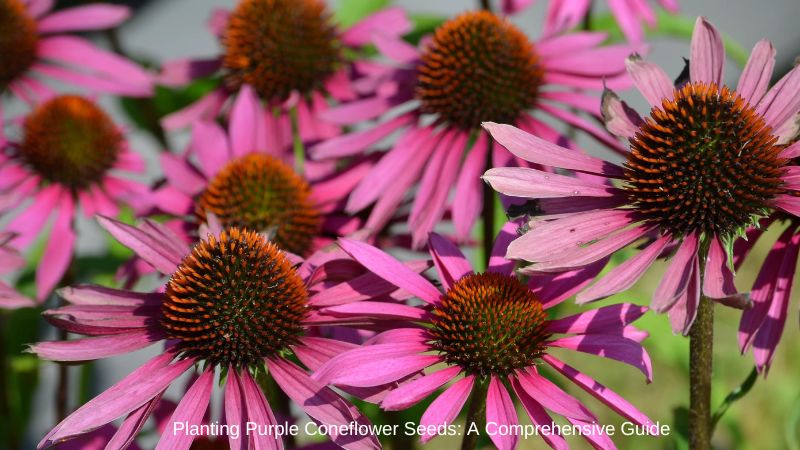Purple coneflower (Echinacea purpurea) is a beloved perennial plant known for its striking purple petals and medicinal properties. Whether you’re a seasoned gardener or just starting, learning how to grow purple coneflower from seed can be a rewarding experience. In this guide, Garden 03 will provide you with everything you need to know about planting purple coneflower seeds, including when and where to plant them, how to care for them, and tips to ensure successful growth.
1. Introduction to Purple Coneflower
Purple coneflowers are native to North America and are part of the Echinacea genus, which includes several species known for their vibrant colors and resilience. Their daisy-like flowers, which bloom in shades of purple and pink, attract pollinators like bees, butterflies, and birds. They are widely used in both ornamental gardening and for medicinal purposes, particularly for boosting the immune system.
Growing purple coneflowers from seed can be a cost-effective way to fill your garden with these beautiful plants. Let’s start by looking at what you’ll need for planting purple coneflower seeds.
2. Choosing the Right Seeds
Before you begin planting purple coneflower seeds, it’s important to choose the right variety. The most common and easily grown variety is Echinacea purpurea, which is favored for its hardiness and adaptability.
Factors to Consider:
- Variety: While Echinacea purpurea is the most popular, other varieties such as Echinacea pallida and Echinacea paradoxa are also available. Each has slightly different flower forms and growth habits.
- Seed Source: Purchase seeds from a reputable supplier to ensure quality. Heirloom seeds are a great option for those wanting to grow coneflowers in their natural, unaltered form.
- Seed Freshness: Ensure that the seeds are fresh for better germination rates. Look for seeds that are labeled for the current growing season.
Once you have your seeds, you’re ready to start the planting purple coneflower seeds process.
3. When to Plant Purple Coneflower Seeds
Timing is crucial when planting purple coneflower seeds. Coneflowers can be planted in both spring and fall, though the best results often come from fall sowing.
Fall Planting
One of the advantages of planting purple coneflower seeds in the fall is that the seeds naturally undergo cold stratification, which improves germination rates. This mimics the natural winter conditions the seeds would experience in the wild.
- Best Time: Late fall, after the first frost.
- Why: The cold weather helps break the seed’s dormancy, allowing it to germinate in the spring.
Spring Planting
Spring planting is also possible, though it may require some additional steps to ensure success.
- Best Time: Early spring, after the last frost.
- Why: Warmer temperatures help seeds germinate, though you may need to stratify them artificially if planting in spring.
For spring planting, it’s a good idea to stratify the seeds by refrigerating them for 4-6 weeks before planting.
4. Preparing the Soil for Planting
The next step in planting purple coneflower seeds is to prepare the soil. Purple coneflowers are adaptable and can grow in a range of soil types, but they thrive in well-drained soil with a neutral to slightly acidic pH.
Soil Preparation Steps:
- Choose a Sunny Spot: Coneflowers prefer full sun, though they can tolerate partial shade. A minimum of 6 hours of sunlight per day is ideal.
- Clear the Area: Remove any weeds, rocks, or debris from the planting area. This reduces competition for nutrients and ensures your seedlings can establish themselves.
- Loosen the Soil: Use a garden fork or tiller to loosen the soil to a depth of 12-15 inches. This helps with root development and drainage.
- Amend the Soil: If your soil is heavy or clay-like, consider adding organic matter such as compost or peat moss to improve drainage.
Purple coneflowers are drought-tolerant once established, but young plants will need good drainage and moisture to thrive.
5. Planting Purple Coneflower Seeds

Now that your soil is ready, it’s time to get to the actual planting purple coneflower seeds process. Whether you’re planting in the fall or spring, the technique remains the same.
Step-by-Step Guide:
- Sow the Seeds: Scatter the seeds lightly on the surface of the soil. Purple coneflower seeds need light to germinate, so avoid covering them with too much soil. A light dusting of soil (about 1/8 inch) is sufficient.
- Spacing: Space seeds about 12-18 inches apart. Coneflowers can grow quite large, so giving them ample room helps prevent overcrowding.
- Watering: After sowing the seeds, water the area gently to ensure good seed-to-soil contact. Keep the soil consistently moist (but not waterlogged) until the seeds germinate.
Germination Time:
- Fall Planting: Seeds will remain dormant until the following spring, when they begin to germinate as temperatures warm up.
- Spring Planting: Expect germination within 10-20 days, depending on conditions.
Once the seeds have sprouted, thin the seedlings to allow enough room for each plant to grow.
6. Caring for Your Purple Coneflowers
Once your purple coneflowers have germinated, it’s important to care for them properly to ensure they flourish.
Watering
Young coneflower seedlings need consistent moisture until they establish deep roots. Water regularly, especially during dry periods. Once established, coneflowers are drought-tolerant and require less frequent watering.
Fertilizing
Purple coneflowers don’t require heavy feeding, but you can give them a boost by applying a balanced fertilizer in early spring. Avoid over-fertilizing, as this can lead to leggy plants with fewer blooms.
Mulching
Applying a layer of mulch around the base of the plants helps retain moisture, suppress weeds, and keep the soil temperature consistent. Organic mulches like shredded bark or straw work well.
Pruning and Deadheading
Deadheading (removing spent flowers) encourages continuous blooming throughout the season. In late fall, you can cut back the plants to the ground. However, leaving some seed heads in place provides food for birds like goldfinches and adds winter interest to your garden.
Pests and Diseases
Purple coneflowers are relatively pest-resistant, but keep an eye out for aphids, caterpillars, or powdery mildew. Most issues can be managed with natural remedies or by improving air circulation around the plants.
7. Benefits of Growing Purple Coneflowers
There are numerous benefits to planting purple coneflower seeds in your garden:
- Attracts Pollinators: Purple coneflowers attract bees, butterflies, and birds, helping to support your local ecosystem.
- Low Maintenance: Once established, these perennials are drought-tolerant and require minimal care.
- Long Bloom Period: Purple coneflowers bloom from mid-summer to early fall, providing long-lasting color in your garden.
- Medicinal Uses: Echinacea has been used for centuries for its medicinal properties, particularly in boosting the immune system and fighting off colds.
8. Harvesting Seeds for Future Planting
Once your purple coneflowers have matured, you can harvest seeds for future planting. Seed heads form in the center of the flower after the petals fall off.
How to Harvest Seeds:
- Wait for the flower heads to dry and turn brown.
- Clip the seed heads and place them in a paper bag.
- Let them dry for a few more days, then gently break apart the seed heads to collect the seeds.
Store the seeds in a cool, dry place until you’re ready to plant them again. Harvesting seeds from your own garden ensures a sustainable way to continue growing purple coneflowers.
9. Conclusion
Planting purple coneflower seeds is a rewarding experience that brings beauty, pollinators, and medicinal benefits to your garden. Whether you’re planting in the fall or spring, following these simple steps will help you grow healthy, vibrant purple coneflowers that can thrive for years. With minimal care, these resilient perennials will reward you with stunning blooms and a garden full of life.
By learning how to grow and care for purple coneflowers, you can create a colorful, low-maintenance garden that attracts wildlife and enhances your outdoor space.





